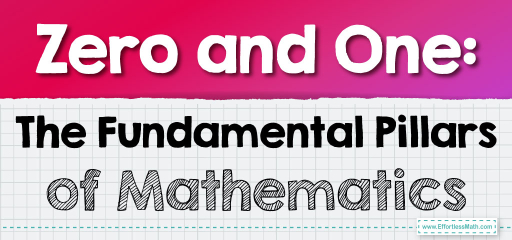Zero and One: The Fundamental Pillars of Mathematics
Understanding the properties of zero and one is fundamental in mathematics, especially regarding operations with real numbers. Let's explore these properties step-by-step.

Step-by-step Guide to Understand Properties of Zero and One
Properties of Zero
- Multiplication with Zero: For any real number \(a\), the product of \(a\) and zero is always zero (\(a×0=0\)). This property is crucial because it underlines that multiplying any number by zero results in zero.
- Addition with Zero: For any real number \(a\), adding zero to \(a\) does not change \(a\) (\(a+0=a\)). Similarly, \(a−0=a\). This is known as the identity property of addition, where zero is the additive identity.
- Subtraction with Zero: Subtracting zero from any real number \(a\) leaves \(a\) unchanged (\(a−0=a\)). However, when zero is subtracted from \(a\) (\(0−a\)), the result is \(−a\), the additive inverse of \(a\).
- Division by a Nonzero Number: For any nonzero real number \(a\), dividing zero by \(a\) results in zero (\(0÷a=0\)). This is because zero divided by any number is always zero.
- Zero Product Property: If the product of two real numbers \(a\) and \(b\) is zero (\(a×b=0\)), then at least one of the numbers must be zero. This property is fundamental in solving quadratic equations.
Properties of One and Minus One
- Multiplication with One: The product of one and itself is one (\(1×1=1\)). This demonstrates that one has a multiplicative identity.
- Multiplication with Minus One: Multiplying minus one with itself gives one (\((−1)×(−1)=1\)), while multiplying minus one with one gives minus one (\((−1)×1=−1\)).
- Identity Property of Multiplication: For any real number \(a\), multiplying \(a\) by one leaves it unchanged (\(a×1=a\)).
- Multiplying with Minus One: Multiplying any real number \(a\) by minus one gives the additive inverse of \(a\) (\(a×(−1)=−a\)).
- Distributive Property of Minus One: For all real numbers \(a\) and \(b\), multiplying the product of \(a\) and \(b\) by minus one gives the same result as multiplying \(a\) by minus one and then by \(b\), or \(a\) by \(b\) and then by minus one (\(−1(a×b)=(−a)×b=a×(−b)\)).
- Negation of Negation: For all real numbers \(a\), multiplying minus one by the additive inverse of \(a\) returns \(a\) (\(−1×(−a)=a\)).
- Division by One: For any real number \(a\), dividing \(a\) by one results in \(a\) itself (\(a÷1=a\)), emphasizing that one is the multiplicative identity.
- Division by Minus One: Dividing any real number \(a\) by minus one gives the additive inverse of \(a\) (\(a÷(−1)=−a\)).
- Successive Integers: For any integer \(n\), adding one to \(n\) yields the next larger integer, and adding minus one to \(n\) gives the next smaller integer.
- Counting and Inverse Addition: The smallest counting number is \(1\). Adding one and its additive inverse (minus one) results in zero (\(1+(−1)=0\)).
- Zero Sum Property: For any real number \(a\), the sum of \(a\) and its additive inverse is zero (\((1×a)+(−1×a)=a+(−a)=0\)).
These properties are vital in algebra and arithmetic, forming the basis for various mathematical operations and problem-solving techniques. Understanding and applying these properties can greatly simplify calculations and conceptual understanding in mathematics.
Examples:
Example 1:
If \(x\) and \(y\) are two numbers such that \(x×y=0\), and \(x=5\), what is \(y\)?
Solution:
According to the zero product property, if the product of two numbers is zero, then at least one of them must be zero. In this case, since \(x×y=0\) and \(x=5\), it means that \(y\) must be \(0\). Therefore, \(y=0\).
Example 2:
If \(a\) is any real number, and you have the equation \(a×1+(−1)×a=b\), what is the value of \(b\)?
Solution:
First, apply the identity property of multiplication, which states that any number multiplied by one is itself. So, \(a×1=a\).
Next, multiplying a number by \(−1\) gives its additive inverse. So, \((−1)×a=−a\).
Therefore, the equation becomes \(a+(−a)=b\).
Since \(a+(−a)\) equals zero (as adding a number and its additive inverse results in zero), we get \(b=0\).
Related to This Article
More math articles
- How to Find the Axis of Symmetry of Quadratic Functions?
- What Are the Applications of the Law of Sines?
- Full-Length 7th Grade SBAC Math Practice Test
- Stretching the Line: How to Multiply Fractions by Whole Numbers with Number Lines
- How to Find the Equation of a Regression Line and Interpret Regression Lines
- A Comprehensive Collection of Free ALEKS Math Practice Tests
- 5th Grade MEAP Math Worksheets: FREE & Printable
- The Great Math Tour: Exploring the World of Circle Graphs
- What is a Perfect SAT Score?
- Fundamental Theorem of Calculus: A Principle That Saves Your Life





















What people say about "Zero and One: The Fundamental Pillars of Mathematics - Effortless Math: We Help Students Learn to LOVE Mathematics"?
No one replied yet.